Building a Sturmgeschütz III Ausf. G
in Finnish Service
STURMI!
By Brett Green
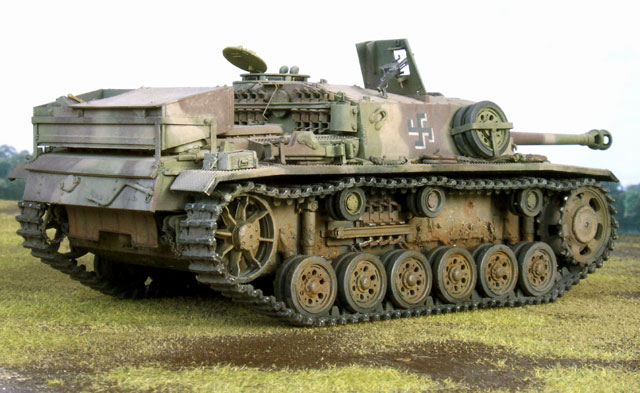
Part Two
Part Two of "STURMI!"
describes the construction of a Finnish Sturmgeschütz III Ausf. G using the
new 1/35 scale Tamiya kit. For details of the history of the SturmGeschütz
III Ausf. G in Finnish service, and specific modifications, camouflage and
markings, see
Part One Modifications, Colours and Markings of The
Continuation War.

Tamiya's 1/35
scale StuG. III Ausf. G is available online from
Squadron.com
I have learnt my lesson. In future, I will complete my research before I finish the model!
After an aborted attempt at building a Sturmi in the early 1990s, I decided
I would build one according to the references I had at the time. I had also
recently bought the 1/35 scale CMK "Finnish Version" StuG IIIG kit.
Although the CMK kit was based on the Tamiya's now outdated original
StuG III Ausf. G kit, I believed that the extras provided in the kit would
offer some short-cuts. The CMK kit contains two large, photo-etched brass;
a few white metal pieces including a DshK Soviet machine gun, a Saukopf
mantlet and a late model gun travel lock; some rather crude injection
moulded parts representing concrete armour fill for the forward
superstructure plus a very nice set of Propagteam decals covering a couple
of German and one Finnish subject. Fortunately I picked this kit up
cheaply, as I only used a few of the CMK pieces and one decal option.
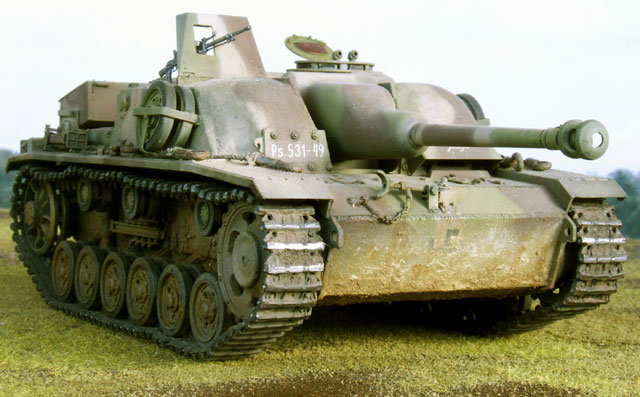
I wanted to base the conversion on the new Tamiya StuG III Ausf. G. Most
of the important CMK replacement parts (including the new gun shield, the
intake screens and the concrete fill) simply did not fit. Further, the
white metal parts were either too crude to use, or more easily replaced
with parts sourced from the spares box. I also relied on the CMK kit
instructions to determine the modifications and markings for this
particular vehicle. Following extensive research preparing the accompanying
research piece, I discovered that CMK's instructions were largely wrong!
What follows, then, is a detailed construction article outlining how to
modify the new Tamiya StuG IIIG without the use of the CMK kit! Due to the
inaccuracy of my primary reference (ie, the CMK kit), the model does not
represent a particular vehicle, but instead displays typical features seen
on Sturmis from July 1944 until the end of the fighting later that year.
For accurate details on modifications, camouflage and markings, see Part
One of this article.
The Tamiya Kit
Much has been much written about the new Tamiya StuG IIIG. Suffice to
say that this is by far the best StuG available on the market today. The
kit features crisp surface features, close attention to details including
very nice tools, individual suspension arms and superbly detailed wheels.
Photo-etched grilles for the intakes and the litter guard above the exhaust
are available separately. This kit is in a category alongside the best of
Tamiya's most recent armour offerings.
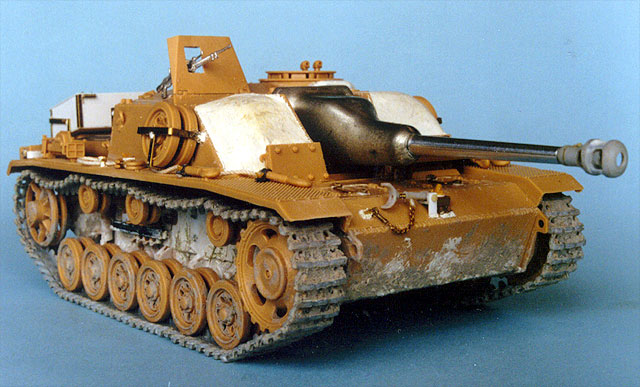
The only criticisms of the kit are some difficult to reach ejector pin
marks on the back of the machine gun shield, schurzen of overscale
thickness and a simplified jack block. Two tow cables are provided but,
strangely, the guides and clamps for the cables are not. Not to forget open
sponsons.
Basic construction is very straightforward and requires little comment.
The assembly of the gun mantlet is the only tricky step. I recommend that
parts D18 are attached to the mantlet block (part D32) and allowed to dry
thoroughly overnight before attempting to attach part D19. The completed
gun block assembly should in turn be allowed to set for 24 hours before
being trapped between the gun mounting arms.
I made a conscious decision not to go overboard with expensive
accessories. Instead I relied on scratchbuilding as far as possible to
demonstrate that a detailed armour model can be built on a reasonable
budget. As discussed in my accompanying reference article, the Finnish army
made many unique modifications to the Sturmgeschütz III. I made the
following changes to represent a vehicle shortly after July 1944.
Lower Hull
I scratchbuilt lower hull applique armour plates from Plasticard. Resin
bolts were sourced from Verlinden. During this initial construction phase,
I pre-weathered the lower hull and tracks by adding mud/gunk texture on
lower hull, lower front and hull sides from goo mixed with fine dirt and
static railway grass.
Spare track rails on the lower hull sides were cut from Plastruct U-beam
and detailed from strip brass. The spare track links were from the Tamiya
kit. Roadwheels needed sanding along the circumference to eliminate the
seam line. However, I left the seam in place for the spare road wheels to
represent factory-fresh items.
|
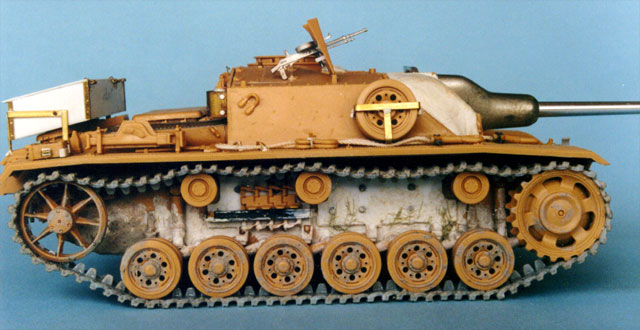
|
|
The applique armour plates added to the lower hull
are visible in this view
- although now somewhat obscured by the mud.
|
Torch-cut detail was added to the lower hull overhang with my Dremel
motortool. Small details included an Eduard mesh litter guard under the
lower hull overhang, I relocated the jack handle onto rear hull per my
references for Finnish StuGs of the period. Exhaust pipes were drilled out
and chains added to the tow shackle pins on the lower rear hull. I used my
"goo" mixture (liquid poly cement and Squadron White Putty) to add surface
texture to the exhausts. I also added a reflector to this area using a
punched styrene disc.
I sourced the two-groove, 40cm track from the Dragon Jagdpanzer IV L/48
set. These were left over from a previous modelling project, but they are
available inexpensively as a separate item from DML. These are excellent
tracks and entirely appropriate for this variety of track that did not have
a lightening hole in the guide tooth.
Upper Hull
A new Notek light mount was cut from brass shim and bent into shape.
Before this was glued in place, I drilled a hole in the hull immediately
underneath the mount and fed a short length of fuse wire through
representing the power lead. The mount base was glued in place and Model
Kasten bolts were added to the front and rear. An Anvil brand Notek light
base was glued to the top of the mount.
 |
|
Rear view of completed model before painting: note the rear storage
box in styrene and corner guards in brass. Also visible is the
mount for the FuG.8 Command Radio, tool storage detail and spare roadwheel mount.
|
Kit tools were enhanced with brass wire release handles and other minor
details. The kit jack block is simplified and required rebuilding. I first
carved off all moulded detail and scored the basic block repeatedly to
represent worn woodgrain. I then added new mounting brackets from scrap
styrene; brass aircraft seatbelts for straps and buckle; and styrene bases
for handles bent from brass wire.
Tow cable brackets were fabricated from lead foil and Anvil brand
wingnuts. The rear guides were made from brass strip. These were superglued
to the Tamiya trackguards. Tow cable loops were attached to the
kit-supplied string with 5-minute epoxy (Araldite). This was smeared over
the top to allow later sanding and blending.
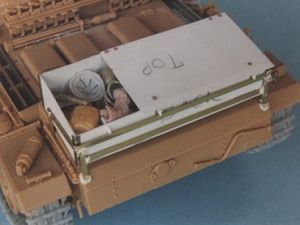 |
|
The storage box - the port-side lid is not in place as of yet (it
is visible in the top view photograph below). |
|
I scratchbuilt the rear stowage box from styrene sheet with the
assistance of my new Chopper cutting tool, thanks for the tip Paul. The
prominent mounting frame was scratchbuilt from brass strip. Box hinges and
corner guard detail was added using brass shim (punched to represent
rivets). Bolts and hinges completed this sub-assembly. Some Finnish stowage
boxes featured a split lid. I represented cluttered contents using various
bits including Dragon accessories; tissue blanket rolls, Hornet German
helmets and a boot that I drilled out and split open.
The prominent Finnish style inspection hatch handles were bent from
brass wire. Short sleeves were cut from brass tube. These were then slipped
over the ends of each handle. A baseplate of scrap styrene was glued to the
front and rear of each outside inspection hatch, and superglue was applied
to the brass sleeves only. The result is a workable handle (but who
cares??)
I enhanced torch-cuts and weld detail with my trusty Dremel Motortool.
and/or putty. Finally, I blanked off the dreaded Tamiya open sponsons!
Superstructure
The characteristic driver's splashguard visor was initially scratchbuilt
from sheet styrene, but I eventually felt that it was too thick. This was
replaced with the CMK brass etched item. However, this item would also be
easy to cut from brass shim or thinner sheet styrene. I blanked off behind
driver's visor with scrap plastic.
The prominent concrete fill seen on Sturmis after July 1944 was built up
on the upper superstructure sides using small balls of Milliput. When
smoothed and dry it was textured with a topcoat of Squadron White Putty.
I borrowed the Commander's cupola armour from the Dragon StuG IIIG Late
kit. This was suitably textured and weld beads added to the base of the
armour. I built a padlock mount for the loaders hatch from brass strip.
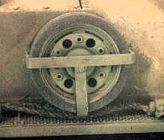 |
|
Spare road wheel and storage rack, starboard hull side, the port
side is similar in detail. |
|
Spare wheel racks for the superstructure sides were scratchbuilt from
brass strip. Weld details were added using Squadron White Putty. As
discussed previously, the seam lines on the spare wheels were not
removed, as new wheels had similar seams.
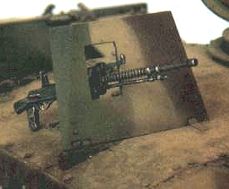 |
|
DT-5 machine gun mounted in shield. |
|
The MG shield was modified to accept the Russian DT5
machine gun. The hole was enlarged; ejector pin marks were filled; a mount
was scratchbuilt from scrap plastic and a hook added from brass wire. A
handle for the top inside of the shield was fabricated from brass wire.
Model Kasten's Soviet DT-5 machine gun was added. This is a really lovely
little white-metal item. The optional shoulder rest and circular ammo
cartridge are provided as separate items.
I scratchbuilt a mount for the engine retaining hooks from
brass shim; and the hooks were bent from very fine electrical wire. This
assembly was attached to the centre of the rear of the superstructure roof.
A new mount for FuG. 8 Command Radio with larger isolator
was required. I built an armoured "pot" surrounding this new base from
brass sheet. Bolts were added using Waldron's punch and die set and a wire
lead-in cable was added to the back of the superstructure from fuse wire.
Gun
Assembly
The L/48 75mm gun assembly was based on the Tamiya mount
and CMK's white metal Saukopf. This Saukopf required additional detailing
on its back face, including bolt mounts and hooks for the weather cover. I
filled the coaxial MG hole on the front, and adapted the metal mantlet to
Tamiya mount.
|
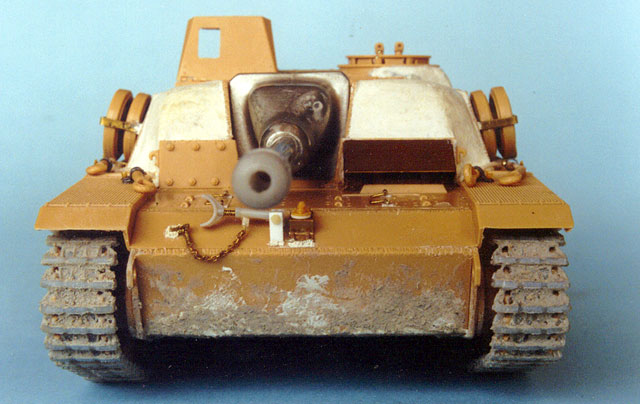
|
|
Details of the gun travel lock
and concrete fill.
|
A late pattern gun travel lock was added. This new travel
lock was based on the item from the Dragon StuG III Ausf. G (late). I built
a new front base plate from brass strip; cut off the cradle and fabricated
a threaded neck by wrapping fine copper electrical wire around steel piano
wire. I drilled the base tube and collar, locating the neck in between. The
hull mount for the retaining chain was built from strip styrene, and
drilled out. A spring was made from fine wire and glued to the chain, which
was in turn glued to the mount. A base for the spring was bent from brass
strip and superglued to the upper front hull. Putty weld beads were added
to the completed assembly, and a prominent Verlinden hex bolt was added to
the front of the mount.
The rubberised-fabric weather cover between the rear of the
mantlet and the front of the roof was formed by carefully manipulating lead
foil. I used the Italeri item (which is about 1/3 too short) to form the
bellows shape. I modelled the fabric torn to see some of the bolt detail
behind mantlet.
I used the CMK, turned metal barrel. The muzzle brake was
rebuilt. The base for this new item was the Dragon L/48 muzzle brake. I
added the circular washer between the baffles (from styrene tube). I glued
the assembly together and reformed the shape of the baffles and front by
using a motor tool as a makeshift lathe and carefully carving the spinning
assembly with the back of a hobby knife. I also engraved a ring at the rear
of the assembly using this method. After significant filling, slots were
cut in front of the rear ring and I glued a small rectangle of styrene in
front of the top slot. A Verlinden bolt was added to complete the muzzle
brake.
I find painting a convincing hard-edged camouflage
scheme to be a real challenge. Give me a mottled finish any time!
Contemporary
photos suggest that Finnish StuGs had a very high quality, hard-edged
finish suggesting that the vehicles may have been spray painted with the
assistance of masks. For more details about Finnish colours and camouflage
schemes, see the accompanying research article.
|
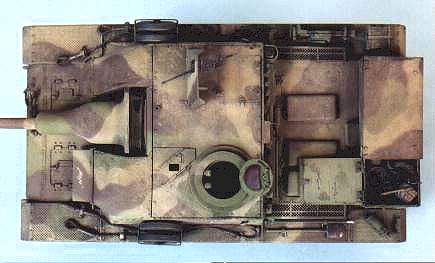
|
|
Overhead view of the completed model. Note the camouflage scheme
and depiction of mud on the engine deck and superstructure top -
this was from the crew climbing on and walking around these areas
|
|
I first sprayed a base coat of black. This reverse shading
leaves convincing shadows in all those crevices and dark places. The next
step was to spray a coat of Moss Green overall. I used a mix of Gunze's new
acrylic German Dark Green lightened with Dark Yellow.
I then hand-painted a
thin outline of the brown disruptive colour (using Gunze 406 Schokoladenbraun) and carefully filled in this outline using my Testors
airbrush. The final colour is a light grey. I used a mix of Tamiya XF55
Deck Tan (40%), XF19 Sky Grey (40%) and 20% Flat White to achieve this
colour. I repeated the previous step of brush painting the camouflage
outline and filling it in with the airbrush.
The pre-textured mud was now sprayed a flat light brown. I
mixed a thin oil wash, which was applied to panel lines. A thin brown wash
was used to highlight the mud and dirt.
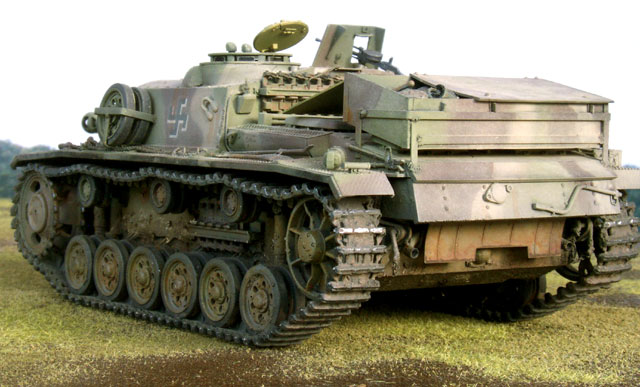
Decals were from the CMK kit, but Finnish decals may be
sourced from a company called "Wiking" (I have a couple of sets and they
are very nice); and Stencilit also provide brass stencils for the relevant
Hakaristi. Finally, a dull coat was applied and a coat of light pastel
chalk dusted over the top. This dusty coat was weathered by painting random
spots of water over the chalk.
This was an enjoyable and challenging project.
|
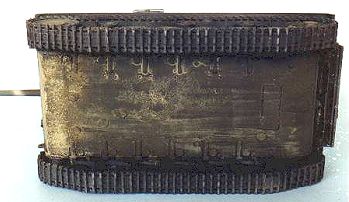
|
|
The underside of the completed, painted and weathered model. Note
that the bottom is relatively mud-free, and streaked, this is
caused by the AFV running over obstructions (bushes, rocks, etc.)
and scraping off any mud that may be on the bottom.
|
|
In summary, the CMK kit is a bit sad by today's standards.
Tamiya's old StuG III (upon which the CMK kit is based) looks
embarrassingly bad when viewed beside the new offering. And although the
brass accessories are very nice, almost nothing fits the new Tamiya
Sturmgeschütz III Ausf. G. Certainly none of CMK's original (and very
crude) plastic parts fit the later kit.
The cast mantlet is quite nice, but a new Saukopf can more
easily be sourced from a Dragon kit. In fact, if you purchase a Dragon "StuG
IV Early", you will get two spare Saukopfs, a spare late StuG III/IV roof
(which is almost a drop fit for the Tamiya kit), and a spare late StuG III
drive sprocket with the hubcap removed and bolts exposed; as well as
various other bits and pieces. Now that is good value for the canny StuG
builder! Thank you Dragon. I cannot really recommend the CMK kit at all. An
interesting idea with a fundamental flaw (i.e. rotten base kit). Nice
decals though.
By contrast, I can recommend the Tamiya Sturmgeschutz IIIG
kit to everybody - novice and expert. Tamiya's new StuG looks great and
almost falls together. With the number of StuG references available, there
are many interesting variations yet to be built. Go build one of them using
this kit!
|
Due to space considerations, the following is not
complete set of references. See also the first part of my article:
Part One Modifications, Colours and Markings of The Continuation
War. The following references proved valuable.
- The Eastern Front, by Steven Zaloga and James
Grandsen, Arms and Armour Press, 1983 ISBN 1-85409-213-8.
- Germany's Eastern Front Allies (Osprey Men at Arms
Series no 131) by Abbott, Thomas and Chappell, Reed
Consumer Books Limited, 1982. ISBN 0-85045-475-1.
- "Finnish Armour", Airfix Magazine May 1976, by
Steven Zaloga and Karl Rosenlof
- "Finnish 'Sturmi'", In Scale Magazine, July 1992,
author unknown.
- IPMS-Mallari (IPMS Finland) Magazine.
-
Various issues including 1/1995 pp.19;
- Sturmgeschutz and its Variants, By Walter Spielberger.
Schiffer Publishing,, 1993. ISBN 0-88740-398-0.
- Achtung Panzer 5 - Sturmgeschütz III, Sturmgeschütz IV
and sIG 33, Dai Nippon Kaiga, 1995. ISBN 4-499-22654-6
- Sturmgeschütz III in Action, By Bruce Culver and Don
Greer. Squadron Signal Publications, 1976. ISBN Number.
- Panzer Colours III, By Bruce Culver and Bill Murphy.
Squadron Signal Publications, 1984. ISBN 0-89747-156-3.
|
|
Home
| What's New |
Features |
Gallery |
Reviews |
Reference |
Forum |
Search